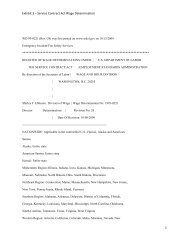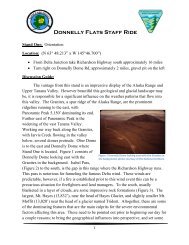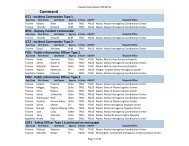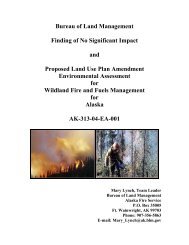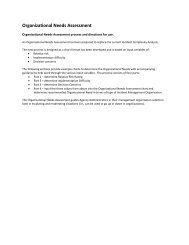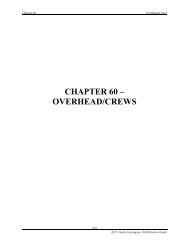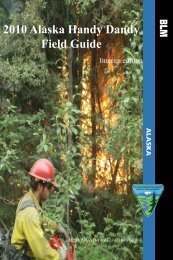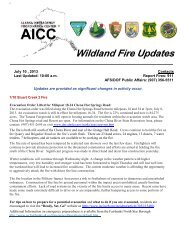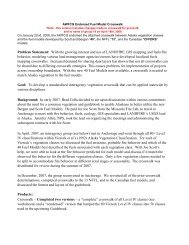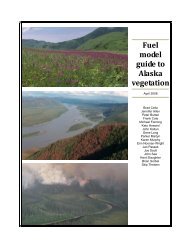AFS Incident Organizer
AFS Incident Organizer
AFS Incident Organizer
- No tags were found...
You also want an ePaper? Increase the reach of your titles
YUMPU automatically turns print PDFs into web optimized ePapers that Google loves.
What is your span-of-control? How many people do you have answering to you? If there are too many tomanage properly, make some changes.1 2 3 4 5 6 7 8 9Optimum ⇑ Too ManyResourcesOrderedqResourceIdentificationResources SummaryDate/ETAAtScenevNo. ofPeopleUse IRPG briefing – inside back cover (when applicable).Location/AssignmentReleasedv( )( )( )( )( )( )( )( )( )( )( )( )( )( )( )( )( )( )( )( )( )( )( )( )( )( )**CHECK FOR WORK-REST STATUS
<strong>Incident</strong> Objectives1. Firefighter andPublic Safety.Is there a life-safety or evacuationproblem?Planning CheckNo Limited Yes2. Structure loss potential? None Possibly High3.Environmental/archaeologicalsensitive areas?InprogressAlreadyInvolvedNo Limited Yes Unknown4. Resistance to control? None Some Moderate HighYour goal is tomanage the incidentand not createMulti-Agency No 1 2 3+Do you have enough resources?YesTo bedeterminedNot sureanother. Probability of success? High Moderate Low PoorNoINCIDENT ORGANIZATION<strong>Incident</strong> CommanderCommand StaffOperationsStagingAir OperationsRadio FrequenciesNetFrequencyCommandRxTxSupport/DispatchRxTxAir-to-GroundRxTxAir-to-AirRxTxTac 1RxTxTac 2RxTxNamePhone NumbersNumber
Date/TimeWet BulbTemperatureRelativeHumidity (%)Wind Speed(mph)Over 45 35-45 20-35CalmDry BulbTemperature Slope (%) FlatRelativeHumidity (%)WindDirectionWind Speed(mph)Today’s ERC or BI of Unit Record Here:Under10Under15Under2010-20 Over 2015-10 Over 30Aspect North East West SouthFlameLengthUnder 2’ 2’ to 4’ 4’ to 8’ Over 8’Spreading None Minor Moderate ExtremeTime of Day2000-10001600-20001000-12001200-1600Map Sketch
Hazard Evaluation18 Situations that shout “Watch Out!”Hazard ControlStandard Firefighting OrdersPresentAbsentFire not scouted and sized up.In country not seen in daylight.Safety zones and escape routes not identified.Unfamiliar with weather and local factors influencing firebehaviorUninformed on strategy, tactics, and hazards.Instructions and assignments not clear.No communication link with crew members/supervisor.Constructing fireline downhill with fire below.Attempting frontal assault on fire.Unburned fuel between you and the fire.Cannot see main fire, not in contact with anyone whocan.On a hillside where rolling material can ignite fuel below.Weather is getting hotter and drier.Wing increases and/or changes directions.Getting frequent spot fires across line.Terrain and fuels make escape to safety zones difficult.Taking nap near fireline.What other safety hazards exist?List any other hazards and what you will do to mitigate them.………………………………………………………………….………….…………………………………………………………………………….…………………………………………………………………………….…………………………………………………………………………….(Use IRPG for other hazard ID & mitigation.)qqqqqqqqqqKeep informed on fire weather conditions andforecasts.Know what the fire is doing at all times.Base all actions on current and expected firebehavior.Have escape routes and safety zones, and makesure they are known.Post a lookout when there is possible danger.Be alert, keep calm, think clearly and actdecisively.Maintain prompt communications with yourforces, your supervisor and adjoining forcesGive clear instructions and be sure they areunderstood.Maintain control of your forces at all times.Fight fire aggressively, but provide for safetyfirst.Have you complied with LCES?qqqqLookoutsCommunicationsEscape RoutesSafety ZonesYes No Decision PointsControls in place for identified hazards?If no, reassess your situation.Are selected tactics based on expected firebehavior? If no, reassess your situation.Have instructions been given andunderstood? If no, reassess your situation.INITIATE
Date/TimeSUMMARY OF ACTIONS (ICS 214)Major Events(Important decisions, significant events, briefings, reports on conditions, etc…)Current StatusSituation StatusProjected StatusRESOURCESSITUATION
Work Rest Ratio Documentation WorksheetThis worksheet is designed to help IC’s document and calculate amount of rest required to meet the 2:1 Work/Restguidelines.- Initial Attack operational period is not to exceed 24 hours except if Agency Administrator approves if 1)accomplish immediate and critical objectives or 2) address immediate and critical firefighter or public safetyissues.- The operational period commences when the employee comes on duty that morning. Subsequentoperational shifts are not to exceed 16 hours.- Rest Time is defined as time when the employee has the opportunity to sleep.DateResourceOperationalPeriod StartTimeOperationalPeriod StopTimeTotal HoursWorkedRest Time(document hourswhen employee ormodule rested)Approval for shift lengthsexceeding 16 hrs given by:IC Signature:Date/TimeApproval Given:Date:
Official Document for Extended Work ShiftAnd/orDeviation From 2:1 Work Rest PolicyDate: Time: <strong>Incident</strong> Number: <strong>Incident</strong> Name: Unit:<strong>Incident</strong> Type: Operational Period: <strong>Incident</strong> Commander: IC Type (1-5)Name of Individual(s) or Crew:JustificationDescription of Situation: (Y)Shifts in excess of 16 hours on __________________________________ was due to:q Travel Time not administratively controllable.q Mobilization and travel of resources to incident location or relocation to incident facilities.q Establishing and maintaining administrative, planning, and logistical support for incident.q Evacuation, triage, structure protection, or emergency rescue.q Establishing initial control of lines of the fire.q Extended attack efforts to control potentially devastating incident activity.q <strong>Incident</strong> unable to provide personnel with adequate food and lodging.q Other/Additional:Extended hour(s) Date: Work Hours: Total Hours:Rational: (Y)q Emergency mobilization of resources to and from incident or facilities.q Efforts required setting up, supporting, and undertaking incident control actions.q Imperative operational defensive actions to prevent loss of life, resources and property damage.q Extenuating circumstances resulted in personnel being left on-location without food and lodging.q Other/Additional:Mitigation MeasuresActions taken to reduce impact on firefighter safety and reduce fatigue: (Y)q Rest extended into the following operational period. Hours adjusted ________ On shift by:q Other:Mitigation hour(s) Date: Hours: Total Hours:<strong>Incident</strong> Supervisor
Spot Weather Observation and Forecast Request1. Name of <strong>Incident</strong> or Project 2. Control Agency:3. Request MadeDate:Time:4. Location: (Township, Range, Section) 5. Drainage Name: 6. Exposure / Aspect7. Size of <strong>Incident</strong> or Project (ac.):11. Weather Conditions at <strong>Incident</strong> or Project or from RAWS:PlaceElev.ObservationDate/Time8. Elevation 9. Fuel Type: 10. Project On:Top:Bottom:GroundCrowningWind Direction/TemperatureVelocity20 ft Eye-level Dry bulb Wet bulb RH DPSky ConditionThe Weather Forecaster will furnish the information for block 13Date/Time:13. Discussion and Outlook:
AFTER ACTION REVIEW<strong>Incident</strong> Name:IC:Date IC Type: Resources:Critiqued by: (List names of attendees)The purpose of this After Action Review is to evaluate decisions, actions and how well they worked. Were they withinthe Standard Operating Procedure and the rules?AAR Leader Signature:Reviewed by:Date:Date:Comments: (Refer to Page 16 of the IRPG for recommended format of AAR Questions. Comment as applicable.)
<strong>Incident</strong> Status Summary (ICS-209)1: Date 2: Time 3: Initial | Update | Final| |6: <strong>Incident</strong>Kind/Strategy7: Start DateTime8:Cause9: <strong>Incident</strong>Commander4: <strong>Incident</strong> Number 5: <strong>Incident</strong> Name10: <strong>Incident</strong> CommandOrganization11: State-Unit12: County 13: Latitude and LongitudeLat:Long:Ownership at Origin:15:Size/AreaInvolved16: %Contained orMMA17: ExpectedContainment Date:14: Short Location Description (in reference to nearest town):18: Line toBuild19: Estimated Coststo Date20: Declared ControlledDate:Time:21: Injuries thisReporting Period:22: Injuriesto Date:25: Threat to Human Life/Safety:Evacuation(s) in progress ----No evacuation(s) imminent --Potential future threat --------No likely threat ---------------23: Fatalities 24: Structure InformationType of StructureResidenceCommercial PropertyOutbuilding/Other26: Projected incident movement/spread in 12, 24, 48 and 72 hour time frames:12 hours:24 hours:48 hours:72 hours:# Threatened # Damaged # Destroyed27: Values at Risk: include communities, critical infrastructure, natural and cultural resources in 12, 24, 48 and72 hour time frames:12 hours:24 hours:48 hours:72 hours:28: Critical Resource Needs (amount, type, kind, and number of operational periods in priority order in 12, 24,48 and 72 hour time frames): ex. 3 CRW1 (4); 1 HEL1 (5);12 hours24 hours:Updated: March 2009
Agency43: Committed ResourcesCRW1 CRW2 HEL1 HEL2 HEL3 ENGS DOZR WTDR OVHD CampSR ST SR ST SR SR SR SR ST SR ST SR SR CrewsTotalPersonnelTotal44: Cooperating and Assisting Agencies Not Listed Above:Approval Information45: Prepared by: 46: Approved by: 47: Sent to: By:Date:Time:



